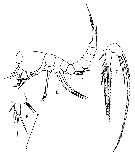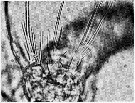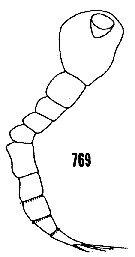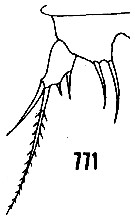|
|
 |
|
Harpacticoida ( Order ) |
|
|
|
Thalestroidea ( Superfamily ) |
|
|
|
Miraciidae ( Family ) |
|
|
|
Distioculus ( Genus ) |
|
|
| |
Distioculus minor (T. Scott, 1894) (F,M) | |
| | | | | | | Syn.: | Miracia minor T. Scott, 1894 b (p.102, figs.F,M); Thompson & Scott, 1903 (p.237, 257); Steuer, 1935 a (p.393, fig.F, carte); Lang, 1948 a (p.770, figs.F,M); De Decker & Mombeck, 1964 (p.14); ? Soyer-Gobillard, 1965 (p.224, figs.F); Neto & Paiva, 1966 (p.36, Table III); Owre & Foyo, 1967 (p.105, figs.F,M); Wells, 1970 (n°133, p.5, figs.F,M); Razouls, 1972 (Annexe: p.146, figs.F,M); Boxshall, 1979 (p.235, figs.F,M, Rem.); Björnberg & al., 1981 (p.677, figs.F,M); Kovalev & Shmeleva, 1982 (p.85); Greze & al., 1985 (p.8); Bradford-Grieve & al., 1999 (p.886, 968, figs.F,M); Böttger-Schnack, 1995 (p.93); Suarez-Morales & Gasca, 1998 a (p.113); Gallienne & al., 2004 (p.5, tab.3); Khelifi-Touhami & al., 2007 (p.327, Table 1);Raybaud & al., 2008 (p.1765, Table A1); Macrosetella oculata : Sewell, 1947 (p.290) | | | | Ref.: | | | Huys & Böttger-Schnack, 1994 (p.243, figs.F,M); Böttger-Schnack, 1996 (p.1088); 1997 (p.410); Conway & al., 2003 (p.212, figs.F,M, Rem.); Boxshall & Halsey, 2004 (p.345: fig.F); Vives & Shmeleva, 2010 (p.110, figs.F,M, Rem.); Benedetti & al., 2016 (p.159, Table I, fig.1, functional characters) |  issued from : G.A. Boxshall in Bull. Br. Mus. nat. Hist. (Zool.), 1979, 35 (3). [p.236, Fig.16, E-G]. As Miracia minor. Female (Syntype from Gulf of Guinea): G, P5. Nota: Cuticular lenses not touching. P5 with 4 setae on baseoendopod, 1 very long and plumose, and 6 setae on exopod Male: E, habitus (lateral); F, P5. Nota: P5 with 2 setae on baseoendopod and 4 setae on exopod, 2 distally and 2 on the lateral margin.
|
 issued from : G.A. Boxshall in Bull. Br. Mus. nat. Hist. (Zool.), 1979, 35 (3). [p.235]. Armature formula of swimming legs P1 to P4. Roman numeral = spine; arabic numeral : seta; from inner to outer.
|
 issued from : M.-O. Soyer-Gobillard in Vie et Milieu, 1965, XVI (1A). [p.224, Fig.1]. As Miracia minor. With doubt. Female (from Banyuls-sur-Mer): habitus (lateral). Nota: The specimen bera carried two egg-sacs, each with 4 eggs.
|
 issued from : M.-O. Soyer-Gobillard in Vie et Milieu, 1965, XVI (1A). [p.225, Fig.2]. As Miracia minor. With doubt. Female: P5. Nota: leg 2-segmented; large inner lobe , which reachs approximately 1/3 of the exopodite, armed with 5 setae, the inner distal well developed. Exopodite 3 times as long as broad, with 6 setae; 3 outer well developedlike 2 inner distales,the outer distal thin and short.
|
 issued from : M.-O. Soyer-Gobillard in Vie et Milieu, 1965, XVI (1A). [p.225]. As Miracia minor. With doubt. Female: Chetotaxy of the swimming legs P2 to P4. Nota: P1 3-segmented, with exopodite , 2nd segment with 1 innner seta, distal with 4; endopodite 2-segmented with proximal segment, elongated, armed with 1 inner seta; distal segment, short.
|
 issued from : C. Razouls in Th. Doc. Etat Fac. Sc. Paris VI, 1972, Annexe. [Fig.101]. Female (from Banyuls, G. of Lion): A, A2; B, P5. Male: C, posterior part of urosome (dorsal); D, P5.
|
 issued from : H.B. Owre & M. Foyo in Fauna Caribaea, 1, Crustacea, 1: Copepoda. Copepods of the Florida Current. 1967. As Miracia minor. After T. Scott (1894).[p.106, Fig.769]. Female: 769, habitus (lateral
|
 issued from : H.B. Owre & M. Foyo in Fauna Caribaea, 1, Crustacea, 1: Copepoda. Copepods of the Florida Current. 1967. [p.106, Fig.770]. As Miracia minor. Female: 770, P5.
|
 issued from : H.B. Owre & M. Foyo in Fauna Caribaea, 1, Crustacea, 1: Copepoda. Copepods of the Florida Current. 1967. [p.106, Fig.771]. As Miracia minor. After T. Scott (1894). Male: 771, P5.
| | | | | Compl. Ref.: | | | Rezai & al., 2004 (p.490, tab.2, Rem.); Medellin-Mora & Navas S., 2010 (p.265, Tab. 2) | | | | NZ: | 7 | | |
|
Distribution map of Distioculus minor by geographical zones
|
| | | | | | | | | | Loc: | | | South Africa (E), off Tristan da Cunha (N & E), Angola, Baia Farta, G. of Guinea, of S Cape Verde Is., off NE Amazon, Caribbean, Caribbean Colombia (San Andrés y Propvidencia), G. of Mexico, ? Gibraltar (in Thompson & Scott, 1903), Medit. (Alboran Sea, Gulf of Annaba, Banyuls, G. of Lion, Ligurian Sea, Lebanon Basin, off Mouth of the Nile), Red Sea, G. of Aden, Arabian Sea, SW Indian, Rodrigues Is. - Seychelles, Mascarene Basin, Straits of Malacca | | | | N: | 24 | | | | Lg.: | | | (57) F: 0,93; M: 0,93; (138) F: 0,93-0,9; M: 0,93-0,82; (721) F: 0,915-0,795; M: 0,92-0,77; (722) F: 1,74-0,93; M: 1,45-0,83; (991) F: 0,79-0,91; M: 0,77-0,92; {F: 0,79-1,74; M: 0,77-1,45} | | | | Rem.: | epipelagic.
Soyer-Gobillard (1965, p.223) describes a female (LG.: 0,83 mm) sampled in Banyuls-sur-Mer (NW Mediterranean Sea) for which the chaetotaxy is not compatible with the chaetotaxy given in Boxshall (1979). If this form is not considered as a new species (maybe an anomaly), it would be the first locality record in the Mediterranean Sea. However, the individuals I have collected at Banyuls (C.R.) are entirely conform to the description of the species.
For Boxshall (1979, p.235) there is some confusion in the litterature over the armature of P5 in both sexes. This arose because Scott (1894) in his original description illustrated 7 setae on the female P5 exopod, and no outer margin seta on the basoendopod. Examination shows that the armature of the female P5 comprises 1 outer margin seta on the baseoendopod and 6 setae on the exopod in agreement with Giesbrecht (1895). Scott (1894) also figured the exopod of the male P5 with 2 inner margin setae and 2 distal setae. The complete male specimen in the syntype series shows that in the slide prepared by Scott the exopod had been accidentally rotated so the 2 outer margin setae appeared to be on the inner margin. Giesbrecht (1895) figured the male P5 with 2 outer margin setae and 2 distal setae but most other authors (Owre & Foyo, 1967; Wells, 1970) redrew their illustrations from Scott (1894).
See in DVP Conway & al., 2003 (version 1) | | | Last update : 04/12/2020 | |
| | | | I have found 3 male specimens at station: 43º23'N;8º 24'W. Size measure: 823, 762 microns.
Please, let me know how pictures can be uploaded to the web page in order to confirm the accuracy of the species identification?
Sincerely
M. Alvarez-Ossorio
|
| | | Eyes-lens red-orange and separates | |
|
|
|
 Any use of this site for a publication will be mentioned with the following reference : Any use of this site for a publication will be mentioned with the following reference :
Razouls C., Desreumaux N., Kouwenberg J. and de Bovée F., 2005-2024. - Biodiversity of Marine Planktonic Copepods (morphology, geographical distribution and biological data). Sorbonne University, CNRS. Available at http://copepodes.obs-banyuls.fr/en [Accessed April 18, 2024] © copyright 2005-2024 Sorbonne University, CNRS
|
|
 |
 |










